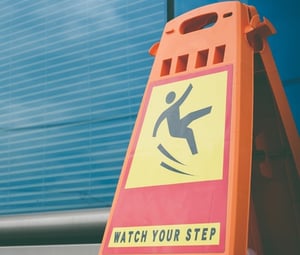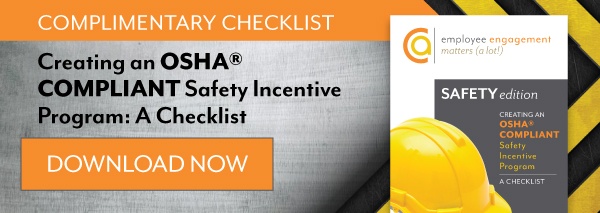
- Introduction to Workplace Safety
- Part 1: State of Employee Safety in the American Workforce
- Part 2: What Is the Best Way to Improve Employee Safety in the Workplace?
- Part 3: Offering an OSHA-compliant Safety Incentive Program
- Part 4: Providing Ongoing Safety Training and Education
- Part 5: Improving Employee Engagement and Employee Recognition
- Part 6: Putting it all Together
We have cars that brake when we’re distracted, homes that shut off the oven when we’re forgetful, and watches that diagnose our health when we feel ill.
By nearly all accounts, we are living in much safer times than previous generations. Yet, while safety-related technology has advanced greatly over the past several decades, our rapid technological advancement hasn’t brought about an equal improvement in workplace safety. In fact, for many industries, workplace safety has actually declined in recent years.
Why have working conditions deteriorated? Can we create safer workplaces? Which action will have the biggest positive impact on employee safety?
We hope to solve these questions within this guide. Here’s the layout for today’s discussion:
- We’ll begin by taking a look at the current state of employee safety in the American workplace. We’ll identify a profound disconnect that occurs year after year, as well as analyze the difficulties facing some of America’s largest industries: manufacturing, warehousing, transportation, and energy and utilities.
- We’ll put our 80+years experience to work for you, as we share the single greatest action you can take to improve workplace safety – creating a Culture of Safegagement. We’ll discuss what Safegagement™ is, how your company can leverage its awesome power, and the tremendous benefits you can experience by adopting a holistic approach to safety.
- We’ll examine what it takes to create a Culture of Safegagement. We’ll begin by analyzing what exactly is an OSHA®-compliant safety incentive program, and what’s the best way to develop one. Later in the chapter, we’ll reveal a popular checklist you can use to create your own incentive program, as well as some leading and lagging indicators you must track.
- We’ll cover why safety education must be a continual process, and we’ll also examine the types of content you should review, how to involve your entire team in the training process, and proven tactics you can use to create the safest work area possible.
- We’ll take a look at two equally important areas of Safegagement — employee engagement and employee recognition. It’s only when we combine these critical elements with a focus on safety can we truly create a Culture of Safegagement.
- Finally, we’ll reveal how you can best leverage your newfound knowledge and apply the principles you learned.
Part 1: The State of Employee Safety in the American Workplace
A powerful disconnect in workplace safety
Despite an increase in governmental regulations, safety conditions have improved little in recent years.
It’s certainly not from lack of trying. Companies around the nation have invested billions of dollars into their safety programs, and many times conditions have actually worsened. This suggests the presence of a powerful disconnect — one that is further illustrated by OSHA’s Top 10 Most Cited Violations list.
Common Safety Violation in the Workplace
- Fall Protection – General Requirements (1926.501)
- Hazard Communication (1910.1200)
- Scaffolding (1926.451)
- Respiratory Protection (1910.134)
- Lockout/Tagout (1910.147)
- Ladders (1926.1053)
- Powered Industrial Trucks (1910.178)
- Machine Guarding (1910.212)
- Fall Protection – Training Requirements (1926.503)
- Electrical – Wiring Methods (1910.305)
What is exceptionally notable isn’t the items on the list, it’s that the list rarely changes! Year after year, companies are cited for the exact same violations. In fact, when there is a change to the list, it makes major headlines. Making matters worse, many companies that are cited are repeat offenders.
Workplace safety challenges by industry
Workplace safety challenges aren’t limited to a particular industry or sector either. Below, we’ve outlined a number of challenges facing many of America’s most popular industries. Regardless of occupation, business type, and even product or service, a danger exists.
Manufacturing
The manufacturing industry is one of the leading most dangerous jobs in the U.S. Each year, 395,000 workplace injuries occur while on the job. A lot of these injuries could have been avoided by following proper safety procedures.
Warehousing
Did you know that 20,000 people are injured from a forklift each year, and 90 people of those who are injured are killed? (Source: Koke Inc.) That’s a lot of incidents that could have been prevented.
The most common injuries that happen in the warehousing industry are slip and falls, lifting, pushing and pulling, and forklift accidents.
Transportation
The transportation industry is among the most dangerous industries to work in. In 2020, more than 3000 truckers died while on the clock. In addition to this, more than 60,000 people died in crashes with trucks and buses.
Coal and Mining
In recent years, Coal and Petroleum Products Manufacturing experienced a 140% increase in fatalities and a 1.2 rate of injury/illness for every 100 employees. With risks of dust inhalation, cave-ins, or gas explosions, it’s no secret to why the coal and mining industry is a dangerous industry to partake in.
Oil and Gas
The oil and gas industry is another industry that has high risks associated with it. In an 11-year stretch, more than 1,300 oil and gas workers lost their lives while on the clock.
Electric Power and Energy
The utility sector has its risks for clear reasons, and it has the highest risk for Serious Injuries or Fatalities (SIF). For every 100 full-time employees, there are 2.2 injuries. In recent years, the industry experienced a near-20% spike in mortality rates.
Water and Sewer
At least two workers are killed each month in trench collapses, and the number of trench fatalities in the U.S. has doubled since 2015.
Sadly, the list only continues to grow over the yearsAnd if we want to dramatically change these results, there’s only one true course of action we can take.
Part 2: What’s the Best Way to Improve Safety in the Workplace?
We’ve been in the employee engagement, recognition, and safety industry for nearly a century. And over that time we’ve heard almost every question you can imagine. However, one we hear the most often is, “what can we do to best improve safety in the workplace?”
Our answer is just five powerful words: “Create a Culture of Safegagment™.” Here’s what that means.
What is Safegagement?
Safety + Engagement = Safegagement
Safegagement is a formula that’s as powerful as it is easy to remember. For starters, it’s exactly what it sounds like: equal parts safety and equal parts engagement. What makes this simple approach so powerful?
Many safety incentive programs on the market focus only on safety. They neglect other core areas like engagement and recognition. Without the kind of holistic approach Safegagement offers, employees quickly lose sight of the big picture. This is one of the reasons why our most successful clients adopt a Culture of Safegagement.
The five components of Safegagement
A successful Safegagement strategy will be 100% customized to meet your business’ needs. However, there are five universal components every plan must contain. We will cover many of these components in the coming chapter, so if you’d like additional clarification just hang tight! If we don’t cover the information you’re looking for in the upcoming pages, you can always email us your questions at info@cashort.com.
Component #1: Leading Indicators
Far too often, businesses focus solely on recording lagging indicators – reactive measurements that track events that have already occurred. However, when companies focus on leading indicators, they can actually prevent safety incidents from ever occurring.
Examples of leading indicators include employees attending and participating in safety exercises, as well as reporting any near-misses that may have occurred.
Component #2: Continuous Training
In today’s sea of distractions, it’s imperative that employees receive continuous and involved training. Safety pamphlets and tutorial videos simply don’t cut it. You need a robust training platform that bolsters active engagement, communication, and participation.
Component #3: Positive Reinforcement
Positive reinforcement is key to creating the kind of long-lasting success your company wants. Reward employees publicly and instantly for their contributions. This will not only reinforce the employee’s positive behavior, it will also motivate their co-workers to take similar actions.
Component #4: Parallel Engagement
As we will discuss in the coming chapters, buy-in is absolutely critical to the success of your safety incentive program. You’ll need participation from your entire team — from part-time workers to seasoned members of the board.
Component #5: Connectivity and Ownership
The cornerstone of your Safegagement strategy is creating an environment that encourages employee ownership. If you need some help in this area, we recommend practicing active listening, hosting engaging meetings, and seeking employee feedback on matters that may impact employees.
You can read more about the Components of Safegagement by downloading our complimentary white paper, Safegagement: Creating Safe Companies that Thrive.
The benefits of creating a Culture of Safegagement
Th e benefits a company will experience as a result of adopting a Culture of Safegagement will depend greatly on your organization’s unique characteristics. However, Gallup’s most recent State of the American Workplace report paints a fairly clear picture.
e benefits a company will experience as a result of adopting a Culture of Safegagement will depend greatly on your organization’s unique characteristics. However, Gallup’s most recent State of the American Workplace report paints a fairly clear picture.
When compared to organizations with lower levels of employee engagement, those with higher levels of engagement typically experience:
- 41% lower absenteeism
- 24% lower turnover (high turnover industries)
- 59% lower turnover (low turnover industries)
- 28% less shrinkage
- 70% fewer employee safety incidents
- 58% fewer patient safety incidents
- 40% fewer quality incidents (defects)
- 17% higher productivity
- 20% higher sales
- 21% higher profitability
Part 3: Offering an OSHA®-Compliant Safety Incentive Program
One of the most effective means of creating a Culture of Safegagement at any organization is to offer an OSHA-compliant safety incentive program. But for many years, there was a great deal of confusion surrounding what, exactly, is an OSHA-compliant safety incentive program. In fact, many businesses have asked if safety incentive programs can even be OSHA-compliant.
Can a safety incentive program be OSHA-compliant?
For clarification on whether or not a safety incentive program can be OSHA-compliant, we turn to OSHA’s own Dr. David Michaels:
“By working cooperatively, OSHA and its VPP partners can demonstrate that good incentive programs, which emphasize positive worker involvement in safety and health activities and conscientious hazard reporting and correction, can be one element in an effective injury and illness prevention program."
So, yes! A comprehensive safety incentive program can be 100% OSHA-compliant. But how can a company be certain a given safety program qualifies? Well, for starters, the program will focus on the 10 elements of safety awareness!
The 10 elements of safety awareness
If your company is looking to create an OSHA-compliant safety incentive program that works, it must include the following 10 elements of safety awareness.
- Simple and well-defined rules – Many times, management creates policies and safety requirements in a vacuum. That means while rules may seem cut and dry to them, employees might find them confusing.
- Accumulation design – The design of your safety incentive program must take into account all areas of safety awareness. Further, it must be combined with proven technology that can deliver a sophisticated level of performance.
- Short-term recognition periods – Recognizing employees for their contributions shouldn’t be something that occurs once a year (or never). Employees should be acknowledged frequently and in as close to near-time as possible.
- Individual recognition – While it’s great to acknowledge an entire team for their superior efforts, it’s equally important to recognize employees on the individual level.
- Human interaction and peer recognition – While providing top-down recognition from a manager to an employee is essential, it’s equally important for employees to praise their co-workers.
- Useful and desirable awards – An incentive award program won’t be very effective if there’s no incentive to get the rewards. That’s why a quality safety incentive program will include a plethora of rewards employees actually want.
- Positive reinforcement and continuous communication -- Research on the mind, body, and spirit is unanimous when it comes to the power of positive reinforcement. Put simply, it works! But, in order to receive the maximum ROI, you must combine positive reinforcement with continuous communication.
- Family involvement for “off-the-job” awareness -- Your employees’ lives don’t end when they clock out. In fact, that’s when their real lives begin! If you’d like for them to carry the safety awareness they learned at the office home, then you need to bring their family into the fold. By encouraging and inspiring an employee’s entire family, you accomplish much more than just by preaching to the same employee.
- Immediate gratification – Humans are driven by immediate gratification. The sooner you can reward employees for taking positive action, the bigger impact you will have. This is why once-a-year bonuses fail to inspire employees to change behaviour. By the time they receive the reward – typically at the end of a calendar year – they’ve forgotten which actions led to the boost in pay.
- Management buy-in and on-going support – For any plan to be successful, you’ll need buy-in from both your managers and your employees. This is one of the benefits of working with a Safegagement firm that can help supply your managers and teams with the resources they need.
3 questions to ask before implementing a safety incentive program
1. Does our safety incentive program reward workers for demonstrating safe work practices?
The first step here is to identify what constitutes “safe work practices.” While always wearing the appropriate clothing and safety garments is essential, so is identifying potential hazards. Your employees should be incentivized for reporting near misses and potentially dangerous situations. Unlike traditional safety incentive programs that aren’t OSHA-compliant, you PRAISE employees who identify risks.
2. How are we incentivizing positive behavior?
This is an essential question every member of management should ask themselves about a safety incentive program. Are you incentivizing positive behavior, and if so, is it effective? The trick here is to give your employees the reward of their choice. But, with so many options, how can you possibly decide which is best for each employee?
The good news is you don’t have to. Let each employee select the reward they want by offering values-based incentive points whenever you observe a praise-worthy action.
3. Are we measuring both leading and lagging indicators?
Finally, you need to be certain your organization is tracking and recording both leading and lagging indicators. Companies have traditionally favored lagging indicators, which only take into account past performance.
Leading indicators, on the other hand, are predictive metrics. And it’s these metrics that hold the true power. When we focus on improving leading indicators, we can better avoid future incidents.
Please keep in mind, this is just a partial list of the questions you should ask about your safety incentive program. For a complete list, be sure to download our complimentary checklist, Creating an OSHA-Compliant Safety Incentive Program.
Leading and lagging indicators to measure
When it comes to tracking leading and lagging indicators, it’s imperative you select a good mix of indicators that indicate both desirable and undesirable actions. This will help you greatly when it comes to encouraging positive behaviors and limiting negative ones.
Let’s look first at some desirable actions.
Desirable Safety Indicator Actions
- Going above and beyond
- An engaged employee is one who takes charge of a situation and goes above and beyond for their co-workers, their team, and their entire organization. When employees exhibit this behavior, they should be publicly recognized for their efforts. This reinforces the positive behavior the employee took and it encourages other employees to take similar actions.
- Report a near-miss accident
- Reporting a near-miss accident might initially be troubling for an employee, as companies have traditionally viewed this action as a negative. However, nothing could be further from the truth. Reporting a near-miss accident makes the work environment safer! This helps employees avoid accidents in the future, and it should be praised!
- Report unsafe conditions
- This is another area where some employees might need a little reassuring. Not every organization is as scrupulous as yours, and as a result, workers have likely been employed by companies who instruct you shouldn’t report unsafe working conditions. This is a crucial mistake, as every worker deserves a safe working environment. To maintain safe working conditions, you need the help of employees who are trained to identify and report potential risks to the appropriate department. Be certain employees feel comfortable doing so!
- Correct unsafe behavior
- Employees should be rewarded for identifying and correcting unsafe behavior. Taking risky shortcuts to finish a job early doesn’t help anyone, least of all the employee, who often faces danger in doing so.
- Attend/Host safety meetings
- On-going safety meetings are essential to creating and maintaining safe workplace environments. In addition to receiving points for attending safety meetings, employees should receive extra points for contributing to and/or hosting safety meetings.
Undesirable Actions
In addition to focusing on desirable actions, your organization should also track leading and lagging indicators that indicate undesirable actions. Here are a few examples of what these might look like.
- Failed to report a safety accident within 24 hours
- When employees fail to report a safety incident in an allotted time, it puts your company in jeopardy. Not only will your company be fined, but another employee may also get injured.
- No call/No show
- When employees fail to show up for their shifts with no advanced warning, you have a major problem on your hands. Often, this is a sign of a disengaged employee – one who can create a world of problems for your organization.
- Issued a safety violation
- Safety violations can cost you more than just fines, so be certain to immediately address any violations.
- Received a report of unsafe driving
- Unsafe driving can cost your company a fortune in fees and litigation. More importantly, it could cost your driver their life.
- Causing a preventable vehicle incident
- Carelessness and distracted driving have many consequences. When drivers aren’t engaged, they get into accidents that are totally preventable.
Please keep in mind, these are just a few of the metrics your organization should track! For a list of 20 Leading and Lagging Indicators to Give You the Edge, you can download our complimentary checklist.
Develop SMARTER key performance indicators (KPIs)
When it comes down to measuring the effectiveness of your safety incentive program, as well as calculating your ROI, it’s essential your organization chooses the right key performance indicators (KPIs). When selecting your KPIs, we recommend that you work SMARTER and not harder.
This simple anagram will save you a tremendous amount of time (and even more money).
S - Specific — Your KPIs must clearly state exactly what you’re measuring! Additionally, you need to agree to a standard unit of measure for all team members.
M - Measurable — You must be able to measure the KPI in order to define a standard and identify notable increases and decreases.
A - Achievable — We all like to dream big, but when it comes to establishing KPIs, you need to pick a realistically achievable goal.
R - Relevant — The KPI must provide additional insight into organizational performance, otherwise it’s irrelevant. If a KPI doesn’t measure a portion of your strategy, there’s no reason to track it.
T - Timely — To gauge your program’s effectiveness, the realization and standardization of the KPI have to be time-based.
E- Explainable — If KPIs are too difficult to explain, miscommunication can easily arise. That’s why KPIs should be easily understood by all stakeholders.
R - Relative — Your KPIs must be relative, so that definitions and goals still apply when your business or volume grows.
Managing your safety-incentive program with a proven SaaS provider
One of the most effective means of managing your safety incentive program is to leverage a proven software as a service (SaaS) solution. By partnering with a quality SaaS provider, you can monitor, manage, and optimize each of the core areas of your safety incentive program.
Just be certain you thoroughly vet the solution provider, as service can vary greatly. At a minimum, the software should allow you to accomplish the following (all of which comes standard with C.A. Short Company’s award-winning SaaS, People Are Everything):
- Set critical rules that promote safety, as well as those that reinforce the values, goals, and mission of your organization
- Seamlessly record and monitor progress across many key metrics
- Easily reward employees for creating a safer environment, going above and beyond the call of duty, or illustrating other behavioral actions you’d like to reinforce. Typically this occurs by rewarding employees with points they can later redeem for the award of their choice
- Promote and facilitate employee recognition — this should occur in both a top-down manner (such as when a manager recognizes an employee) and a peer-to-peer approach (when an employee honors a fellow worker)
 In addition to offering these core functions, we’re exceptionally proud of our new partnership with ProcessMAP. As part of our commitment to unending innovation, we are now leveraging ProcessMAP’s sophisticated data intelligence platform to convert your recorded data into actionable intelligence. Users can now easily consolidate all components of their health and safety programs, as well as proactively identify problems that exist – and better prevent future incidents from occurring.
In addition to offering these core functions, we’re exceptionally proud of our new partnership with ProcessMAP. As part of our commitment to unending innovation, we are now leveraging ProcessMAP’s sophisticated data intelligence platform to convert your recorded data into actionable intelligence. Users can now easily consolidate all components of their health and safety programs, as well as proactively identify problems that exist – and better prevent future incidents from occurring.
Finally, it’s important to remember that it’s not just the software you’re evaluating. It’s equally important to factor in the service that accompanies it. When considering a SaaS solution, properly vet the providers’ reputation, capabilities, and their ability to support you as you onboard, as well as when you’re up and running.
A few of the questions you should ask include:
- How long has the provider been in the safety industry?
- Does the solution easily scale?
- How customizable are the awards and software?
- What type of awards can employees redeem with their points?
- What support solutions exist before, during, and after purchase?
- What guarantees, if any, do they offer?
- What are typical results other businesses in your industry have experienced?
- What is their Net Promoter Score?
- What earned awards or recognition have they won within their industry and from the industries they serve?
- How easy do they make it for you to cancel your agreement if you decide their solution isn’t right for your organization?
Part 4: Providing Ongoing Safety Training and Education
If there’s one thing science has proven, it’s that the “one and done” approach to safety training is a colossal disaster. Instead, workers – and especially millennials – prefer continual feedback that leads to overall growth.
Here are a few ways you can achieve this.
Host weekly safety meetings and let employees choose the topics
Even if everyone is in good standing with their certifications, aware of any and all OSHA updates, and are up-to-date on any industry-specific qualifications, it’s still necessary to have ongoing safety meetings.
If there are no pressing issues that need addressing, allow employees to take ownership of the meetings. Encourage them to choose the topic of a certain week, research the issue, and then drive the discussion.
If you’re hard-pressed for ideas, you can always browse through OSHA’s list of most-cited violations, or you can take a deep dive into OSHA’s comprehensive list of safety and health topics. If you’re really looking to spice things up, consider hosting a five-minute safety topic series, where employees have five minutes to discuss any safety-related topic they deem important.
Tips for making safety meetings fun and encouraging participation
 Just because you're hosting a safety meeting doesn’t mean it has to be boring. In fact, you should go out of your way to ensure it’s as entertaining as it is informative. Otherwise, the important message will never stick. There are many ways you can make your safety meetings fun and encourage active participation.
Just because you're hosting a safety meeting doesn’t mean it has to be boring. In fact, you should go out of your way to ensure it’s as entertaining as it is informative. Otherwise, the important message will never stick. There are many ways you can make your safety meetings fun and encourage active participation.
For starters, you can divide the meeting into teams that will compete against each other for prizes. The team that can answer all the questions correctly, illustrate a particular safety check, or identify a potential hazard is awarded points they can exchange for the award of their choice.
By incentivizing participation and rewarding employees for their contributions, you can bet your bottom dollar your employees will absorb this important information much more readily than if they were watching a safety video or reading a handout. This gets employees excited, active, and engaged – three crucial elements needed for long-term change!
Part 5: Improving Employee Engagement and Recognition
The only way you can create a Culture of Safegagement at your organization is to take a proactive and holistic approach. That means dedicating an equal amount of focus to your employee engagement and employee recognition efforts.
Improving employee engagement
If you’re looking to boost employee engagement at your company, there’s no better place to start than with our comprehensive analysis, How Can My Company Improve Employee Engagement?
Whether you’re a beginner or an engagement pro, this article is sure to be a great resource. In addition to covering how employee engagement is measured, it includes many tips and tricks you can use to boost your engagement efforts today.
If you want additional information, consider the following complimentary resources:
- 3 Ways to Accelerate Employee Engagement
- The 7 New Rules for Employee Engagement
- From Mundane to Magic: The Power of an Engaged Workforce
Improving employee recognition
Recognizing your employees for their hard work and dedication is critical to the success of your Safegagement strategy. This requires more than a once-a-year thank you. Your recognition efforts must also be ongoing. Day-to-day recognition is just as important as special events – like honoring employees with a Years of Service award ceremony.
And just as the case with employee engagement and safety, one of the best ways to improve employee recognition is to utilize a values-based incentive program. By providing feedback in near-real time, you can positively reinforce desirable actions.
Of course, this is just part of the solution. For additional ideas on how you can improve employee recognition at your organization, consider downloading some of our complimentary resources:
- Creating a Total Recognition Program
- Designing an Employee Service Award Program
- 35 Ways to Influence Corporate Culture and Increase Your Bottom Line
- 5 Elements of Recognition
Part 6: Putting A safety Plan Together
There’s a reason so many employers struggle with creating a Culture of Safegagement. That’s because there is no one-size-fits-all solution. Every Safegagement strategy must be customized to meet the unique needs of a given company, their employees, and their industry.
If you’d like assistance building a Culture of Safegagement at your organization, we hope you consider working with C.A. Short Company. We’ve spent 80+ years working in the employee engagement, recognition, and safety industry, and we’d love the opportunity to help your company reach its full potential.
For more information on how we can help you achieve this, please email us at info@cashort.com or give us a call at 800.535.5690.
Editor's Note: This article was originally published on October 12th, 2018 and has been recently updated.

.png)




.jpg)



SHARE